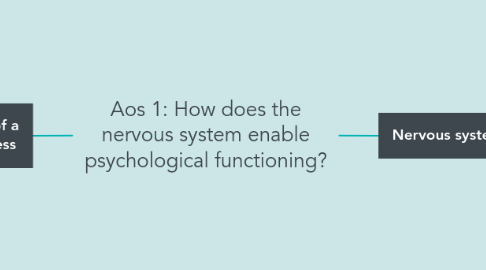
1. Stress as an example of a psychobiological process
1.1. Stress
1.1.1. Prolonged levels of physiological arousal; state of physiological or psychological tension
1.1.2. Eustress
1.1.2.1. refers to a positive psychological response to a perceived stressor
1.1.3. Distress
1.1.3.1. Refers to a negative psychological response to a perceived stressor
1.1.4. Acute
1.1.4.1. Challenging situations that trigger an immediate response and are usually short lives
1.1.5. Chronic
1.1.5.1. Involve situations that are on-going and lead to prolonged levels of physiological stress
1.2. Stressor
1.2.1. The stimulus that causes stress; generally is subjective
1.3. Stress reaction
1.3.1. The physiological and psychological result of stress
1.4. Sources of stress
1.4.1. Daily pressures
1.4.2. Life events
1.4.3. Acculturative stress
1.4.4. Catastrophes
1.5. Models of stress as a biological processs
1.5.1. Fight-flight-freeze response
1.5.1.1. Activated by sympathetic branch of autonomic nervous system
1.5.1.2. Adaptive response
1.5.1.3. Cortisol
1.5.1.3.1. Released through HPA axis
1.5.1.3.2. Maintains blood-glucose levels to provide us with more energy
1.5.1.3.3. Suppresses immune system and digesion
1.5.1.3.4. Reduces inflammation
1.5.1.3.5. Maintains blood pressure level
1.5.1.3.6. Helps to repair muscles and speed up healing process
1.5.1.4. Adrenaline and noradrenaline
1.5.1.4.1. Leads to increase in respiration and heart rate
1.5.2. Homeostasis
1.5.2.1. Maintaining internal equilibrium
1.5.2.2. Allostasis
1.5.2.2.1. The process of change that needs to occur to return the body to homeostasis
1.5.3. Hans Seyle's General Adaptation Syndrome
1.5.3.1. Alarm
1.5.3.1.1. Shock
1.5.3.1.2. Countershock
1.5.3.2. Resistance
1.5.3.2.1. Trying to maintain homeostais
1.5.3.2.2. Increased allostatic load
1.5.3.2.3. Parasympathetic NS reduces heart and respiration rates
1.5.3.2.4. Glucose and cortisol continue to circulate through body
1.5.3.2.5. Energy conservation
1.5.3.3. Exhaustion
1.5.3.3.1. Prolonged levels of physiological arousal due to stress hormones in bloodstream
1.5.3.3.2. Severely depleted resources
1.5.3.3.3. Susceptible to life-threatening illnesses
1.5.3.4. Strengths
1.5.3.4.1. Empirically based info about physiological processes
1.5.3.4.2. Able to demonstrate that exposure to prolonged stress could lead to death in lab rats
1.5.3.4.3. Recognises that the stress response occurs in stages
1.5.3.5. Weaknesses
1.5.3.5.1. Model based on rats, cant generalise to humans
1.5.3.5.2. Failed to recognise the role of emotion and cognition
1.5.3.5.3. Assumed everyone has the same physiological response to any type of stressor
1.6. Models of stress as a psychological pocess
1.6.1. Lazarus and Folkman's Transactional Model of Stress and Coping
1.6.1.1. Stress is regarded as a 'transaction' between the person and their environment, where the person's individual interpretation or cognitive appraisal determines how they will deal with the situation
1.6.1.2. Primary Appraisal
1.6.1.2.1. Immediate, initial judgment of a situation
1.6.1.2.2. Harm/loss
1.6.1.2.3. Threat
1.6.1.2.4. Challlenge
1.6.1.2.5. Benign/neutral
1.6.1.3. Secondary Appraisal
1.6.1.3.1. Person assesses what resources they have to deal with the stressor
1.6.1.3.2. Coping strategies
1.6.1.4. Strengths
1.6.1.4.1. Human subjects were used
1.6.1.4.2. Acknowledges that appraisal and response to a stressor can be highly individual
1.6.1.4.3. Regarded perception and response to a stressor as an interaction between the individual and their environment
1.6.1.5. Weaknesses
1.6.1.5.1. Lack of empirical evidence therefore relying on subjective data
1.6.1.5.2. Less emphasis on physiological elements
1.6.1.5.3. Primary and secondary appraisal could happen at same time
1.6.1.5.4. Primary appraisal may not be clear cut - person may be stressed without knowing why
2. Nervous system functioning
2.1. Divisions of the Nervous System
2.1.1. Central Nervous System
2.1.1.1. Receive, process and respond. Enables the brain to communicate with the rest of the body by conveying and receiving messages from the PNS
2.1.1.2. Brain
2.1.1.2.1. Regulates and guides the NS. Coordinates unconscious and conscious responses
2.1.1.2.2. Forebrain
2.1.1.2.3. Midbrain
2.1.1.2.4. Hindbrain
2.1.1.3. Spinal Cord
2.1.1.3.1. Connects the brain to the rest of the body, initiates spinal reflex
2.1.1.3.2. Spinal reflex
2.1.1.4. Peripheral nervous system
2.1.1.4.1. Works with CNS to enable you to interact with environment. Costs of the network of neurons outside the brain and spinal cord
2.1.1.4.2. Somatic Nervous System
2.1.1.4.3. Autonomic Nervous System
2.1.1.4.4. Sensory Neurons (afferent)
2.1.1.4.5. Motor neurons (efferent)
2.2. The Role of Neurons and Neurotransmitters
2.2.1. Neuron structure
2.2.1.1. Dendrite
2.2.1.1.1. Come off Soma
2.2.1.1.2. Receive information from the pre-synaptic neuron
2.2.1.1.3. Send information from synapse to soma
2.2.1.2. Soma
2.2.1.2.1. Initiates the action potential (neural impulse) to be sent down the axon
2.2.1.2.2. Interprets message recieved by dendrites
2.2.1.3. Axon
2.2.1.3.1. The pathway down which the neural message travels
2.2.1.4. Axon terminals
2.2.1.4.1. Terminal buttons
2.2.1.4.2. Transmits messages to the next neuron (exit pathways for the neural messages)
2.2.1.5. Myelin sheath
2.2.1.5.1. Protects the axon from potential chemical and physical interference to the electrical impulses that travel along it
2.2.1.5.2. Insulation provided by Myelin sheath allows the neural impulse to travel much faster
2.2.2. Synaptic transmission
2.2.2.1. Lock and key process
2.2.2.1.1. Where receptor sites on the dendrites act as 'locks' that can only be opened with a specific neurotransmitter 'key'. Once the neurotransmitter has bound with the receptor the potential of the neuron will either be inhibited or excited
2.2.3. Neurotransmitters
2.2.3.1. Inhibitory
2.2.3.1.1. Firing rate of post-synaptic neuron is reduced - inhibits response
2.2.3.1.2. GABA is the main inhibitory neurotransmitter in the body
2.2.3.2. Excitatory
2.2.3.2.1. Stimulates neuron to fire and reach action potential
2.2.3.2.2. Glutamate is the main excitatory neurotransmitter in the body
2.2.3.3. Changes to neurotransmitter functioning
2.2.3.3.1. Parkinsons's disease
